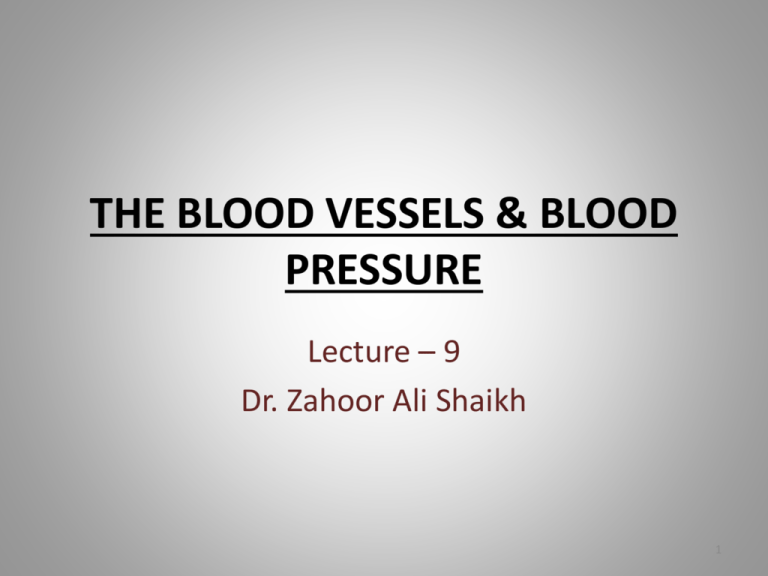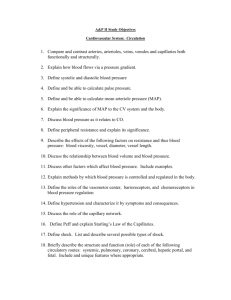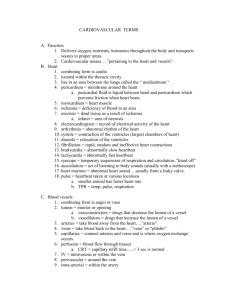THE BLOOD VESSELS & BLOOD PRESSURE
advertisement

THE BLOOD VESSELS & BLOOD
PRESSURE
Lecture – 9
Dr. Zahoor Ali Shaikh
1
BLOOD VESSELS
•
•
•
•
Arteries – pressure vessels [reservoir]
Arterioles – resistance vessels
Capillaries – exchange vessels
Vein – capacitance vessel [blood reservoir]
60 – 70% of blood is in the veins
2
PATTERN & PHYSICS OF BLOOD FLOW
• Blood is transported to all parts of body
through blood vessels.
• Blood vessel bring Oxygen and nutrition.
• They remove waste product.
We will study general principles regarding
blood flow, Physics of blood flow, Role of
blood vessels, then blood pressure
regulation.
3
4
DISTRIBUTION OF CARDIAC OUTPUT
• Digestive organ, kidney, skin receive blood in
excess of their own needs, therefore, can
withstand better main blood flow is reduced.
• Brain suffers irreparable damage when blood
supply is not there for more than 4mins. If
oxygen is not supplied to brain, permanent
damage occurs.
5
BLOOD FLOW
• Blood Flow through a vessel depends on
- Pressure Gradient
- Vascular Resistance
What is Flow Rate of Blood?
• It is volume of blood passing through a vessel per
unit time. Flow rate is directly proportional to the
pressure gradient and inversely proportional to
vascular resistance.
6
BLOOD FLOW
Pressure Gradient Resistance -
Flow
Flow
• F = ΔP / R
F = Flow rate of blood through vessel
ΔP = Pressure Gradient
R = Resistance of blood vessel
7
PRESSURE GRADIENT
• Pressure Gradient is difference in pressure
between the beginning and end of vessel.
• Blood flows from area of high pressure to an area
of low pressure, down the pressure gradient.
• When heart contracts, it gives pressure to the
blood, which is main driving force for flow
through a vessel.
• Due to resistance in the vessel, the pressure
drops as blood flows.
8
9
RESISTANCE
What is Resistance?
• It is measure of hindrance or opposition to blood
flow through a vessel, caused by friction between
the blood in the vessel wall.
• If resistance to flow increases, it is difficult for
blood to pass through a vessel, therefore, flow
rate decreases.
• When resistance increases, the pressure gradient
must increase to maintain the same flow rate.
10
APPLIED
• If vessels offer more resistance to flow
e.g. increased peripheral resistance, which
occurs in high blood pressure then heart must
work harder to maintain adequate circulation.
11
RESISTANCE
• Resistance to blood flow depends on three
factors:
1. Viscosity of blood
2. Vessel length
3. Radius of the vessel – this is most
important.
12
RESISTANCE
•
•
•
•
1. Viscosity of blood
We write η for Viscosity.
Viscosity refers to the friction, which is
developed between the molecules of fluid as
they slide over each other during flow of fluid.
Greater the viscosity, Greater the resistance to
flow.
Blood viscosity is determined by number of
circulating RBC, blood viscosity is increased in
Polycythemia and decreased in Anaemia.
13
RESISTANCE
2. Vessel length
• Greater the length of a vessel, more will be
the resistance.
How length of a vessel affects the resistance?
• When blood flows through a vessel, blood
rubs against the vessel wall, greater the vessel
surface area, greater will be the resistance to
the flow.
14
RESISTANCE
3. Radius of the vessel
• It is the most important factor to determine the
resistance to flow.
• Fluid passes more readily through a large vessel.
• Slight change in radius of a vessel brings great
change to flow because Resistance is inversely
proportional to the fourth power of the Radius
[multiplying the radius by itself four times].
R α 1/r4
15
RESISTANCE
3. Radius of the vessel
• Therefore, doubling the radius, reduces the
resistance to 1/16 its original value.
[r4 = 2×2×2×2 = 16 or R α 1/16]
and there is increased flow through a vessel
16 fold.
• On the other hand, when we decrease the
radius to the half, blood flow will be
decreased 16 times.
16
17
APPLIED
• Clinically radius of arteriole can be regulated
and is the most important factor in controlling
resistance to blood flow throughout the
vascular system.
18
POISEUILLE’S LAW
• The factors that affect the flow rate through a
vessel are integrated in Poiseuille’s Law.
Flow rate = πΔPr4
8ηL
ΔP = Pressure Gradient [ Pressure Gradient = Flow]
r = Radius [ Radius = Flow]
η = Viscosity [ Viscosity = Flow]
L = Length [ Length = Flow]
19
VASCULAR TREE
•
•
•
•
Systemic Circulation
Arteries give small arteries which branch into
many arterioles.
The volume of blood flowing through an organ
can be adjusted by the caliber [internal diameter]
of the arteriole.
Arteriole branch into capillaries – where exchange occurs with the cells.
Capillary exchange is the entire purpose of
circulatory system.
20
SYSTEMIC CIRCULATION
• Capillaries rejoin to form Venules, which
merge to form small veins, that leave the
organ.
• Small veins unite to form large veins, that
empty into the heart.
• The arterioles, capillaries and Venules are
collectively referred as the
MICROCIRCULATION, because they are visible
only through microscope.
21
22
IMPORTANT
• Human Physiology – Lauralee Sherwood
{Page 347}:
If all of the vessels in the body are strung
[connected], end to end, they would circle the
circumference of the Earth twice!
23
SYSTEMIC CIRCULATION
• We will discuss the role of different vessels in
Systemic Circulation.
Arteries
Functions
- Serve as rapid transit passage way for blood from
heart to organs.
- They have large radius, therefore, offer little
resistance to blood flow.
- They act as Pressure Reservoir and provide
driving force for blood when heart is relaxing.
24
SYSTEMIC CIRCULATION
Arteries
Functions [cont]
• Arterial wall has two type of connective tissue –
Collagen Fibers which provide tensile strength
against high driving pressure of blood ejected
from the heart.
– Elastin Fibers which give elasticity to arterial
wall, so that they behave like a balloon.
• Because of elastic recoil, pressure is maintained
in the arteries, therefore, blood flows to the
organs when heart is relaxing.
25
26
27
ARTERIAL BLOOD PRESSURE
What is Blood Pressure?
• It is the pressure or force exerted by the blood
against the vessel wall.
Systolic Pressure - It is maximum pressure
exerted in the arteries during systole of
ventricle. Average 120mm Hg.
Diastolic Pressure – Minimum pressure within
the arteries during the diastole of ventricle.
Average 80mm Hg.
28
ARTERIOLES
• Artery branches into numerous arterioles within the
organ.
• Arterioles are the major resistance vessels.
WHY?
• Because their radius is small.
• As arteriolar resistance is high, it causes marked drop
in mean pressure as blood flows through arteriole.
• Mean Arterial Blood Pressure [ABP] of 93mm Hg in
arteries falls to mean ABP of 37mm Hg as blood leaves
the arteriole and enters the capillaries.
29
30
ARTERIOLES
• Arteriolar Resistance converts the pulsatile
systolic to diastolic pressure swings in the
arteries into the non-fluctuating pressure
present in the capillaries.
• Radius of the arteriole can be adjusted to
achieve 2 functions:
i). Adjust blood flow to the organs
ii). To help to regulate blood pressure
31
ARTERIOLES
• Arteriolar Resistance - it is affected by
- vasoconstriction [means narrowing of vessel] and
vasodilation [increase in circumference and radius of
vessel].
• Arteriole have less elastic tissue, but thick layer of smooth
muscle, which is innervated by sympathetic nerve fibers.
VASCULAR TONE
• Arteriolar smooth muscle has vascular tone, that is partial
state of constriction due to cytosolic concentration of Ca2+.
32
ARTERIOLES
• Many factors can increase or decrease the tone and can cause
vasoconstriction and vasodilation.
Causes of VASOCONSTRICTION
- Sympathetic Stimulation
- Epinephrine and Nor Epinephrine
- Angiotensin II
- Vasopressin
- Endothelin [from endothelial cells]
- O2
-
CO2
- Cold
33
ARTERIOLES
CAUSES OF VASODILATION
- Decreased sympathetic stimulation
- Nitric oxide [released by endothelial cells and other tissue,
it is local mediator]
- Histamine
- Adenosine
- Prostaglandin
- Decrease Oxygen
- Increased CO2
- Increase H+ ion
- Increase K+
- Heat
34
35
ACTIVE HYPEREMIA
• When local factors cause vasodilation, there is increased
blood flow.
• This increased blood flow in response to increased tissue
activity is called ACTIVE HYPEREMIA.
Auto Regulation
• It is through local arteriolar mechanism which keeps blood
flow constant despite changes in mean arterial blood
pressure.
• E.g. brain – auto regulation is best
kidney – auto regulation is good
skeletal muscle – auto regulation is poor
36
SYMPATHETIC CONTROL OF
ARTERIOLE
• Sympathetic Control of Arterioles is important in
regulating blood pressure.
• Sympathetic ANS supplies arteriolar smooth
muscle all over body except brain.
• Increase sympathetic stimulation causes
arteriolar vasoconstriction.
• Decrease sympathetic stimulation causes
arteriolar vasodilation.
• There is no parasympathetic innervations to
arterioles.
37
WHAT YOU SHOULD KNOW FROM
THIS LECTURE
• Pattern & Physics of Blood Flow
• Flow, Pressure, Resistance Relationship
• Types of Blood Vessels & their Functions E.g. Arteries,
Arterioles, Capillaries, Veins
• Formula For Flow Rate
• Factors Affecting Resistance – Viscosity, Vessel Length,
Radius of the Vessel
• Vascular Tree – Functions of Arteries, Arterioles
• Factors Causing Vasoconstriction and Vasodilation
• Active Hyperemia
• Auto Regulation
• Sympathetic Control of Arteriole
38
THANK YOU
39







